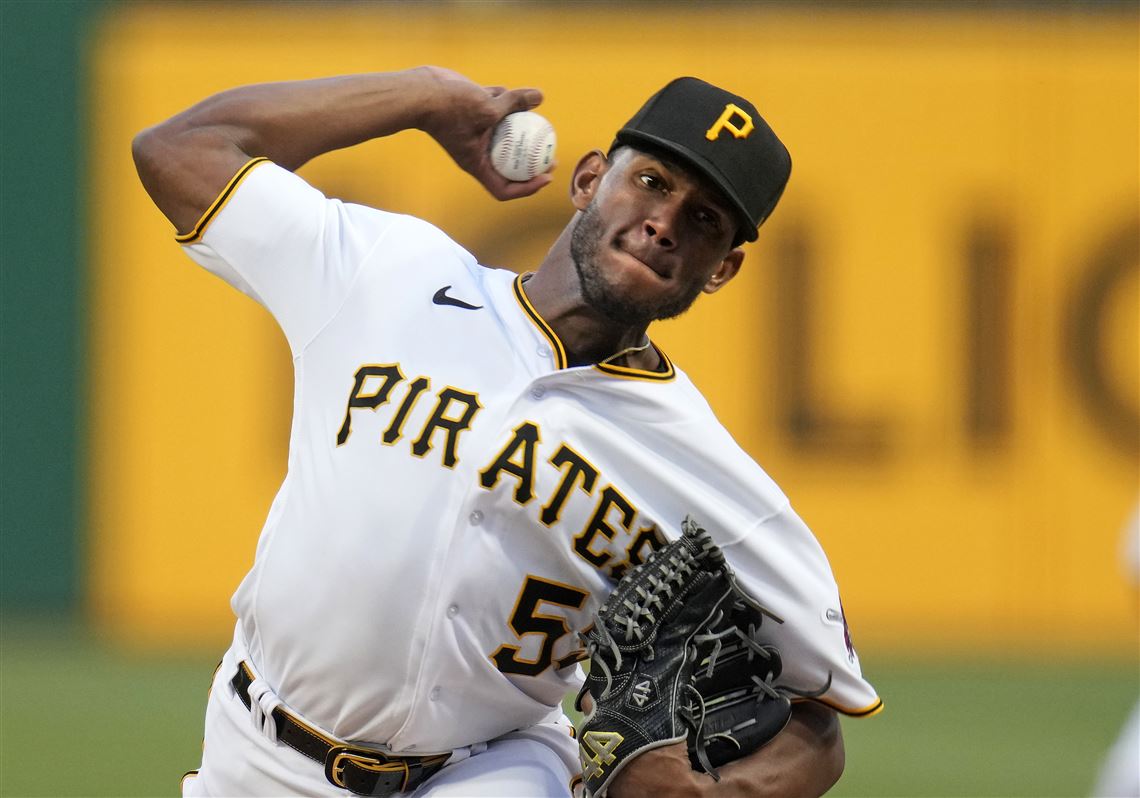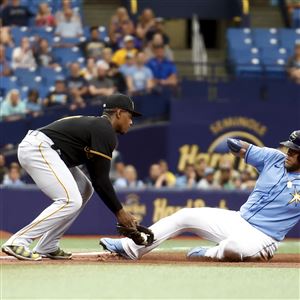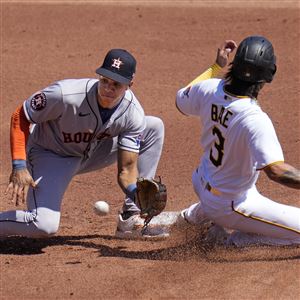Oscar Marin knew the Pirates had to get better at loading up the strike zone.
Entering his fourth season as the team’s pitching coach, Marin tasked his group with improving upon a 2022 campaign in which they threw strikes at Major League Baseball’s third-lowest clip. During the Pirates’ current 18-8 start, they’ve certainly accomplished that goal, loading up the zone with the ninth-highest percentage of strikes en route to putting up the eighth-best team ERA in MLB.
But the Pirates aren’t simply blowing past their opponents with sizzling fastballs; instead, they’re spinning them into a frenzy. Per Baseball Savant, over 37% of Pirates pitches this season have been either a slider or curveball, more than any other team in the league.
“This was our big talk in spring, about filling up the zone — what are our best pitches to fill up the zone?” Marin told the Post-Gazette. “For a lot of our guys, our higher-percentage strike pitches were the slider. We said it a million times with our group: we’re going to throw our best stuff in the zone.”
The Pirates’ staff has certainly taken this mantra to heart, recognizing they can turn to other pitches besides their fastballs (which they use a few ticks over 30% of the time, good for 19th-most) to produce effective outings.
Starters like Roansy Contreras, Johan Oviedo and Vince Velasquez are all in the top six in baseball for slider usage, each throwing the pitch over 40% of the time. Over ⅕ of Oviedo’s offerings have been curveballs, too, which coincides with what’s been a breakout season thus far for the 25-year-old right-hander.
Back as a full-time starter after being relegated mostly to bullpen duty with the Chicago White Sox last season, Velasquez has had a resurgence, due in no small part to nearly doubling his slider usage. Despite losing a few ticks off his fastball, Contreras remains effective, as his slider has turned into his most frequently thrown pitch in 2023.
Since Marin started overseeing the Pirates’ pitching staff, off-speed usage has been a priority, but not quite to the same degree as this season. In the shortened 2020 campaign, the Pirates threw MLB’s fourth-most sliders but were also forced to deliver the fifth-most pitches in a forgettable 19-41 season.
Onlookers like right-hander JT Brubaker, who is sidelined for the season after getting UCL reconstructive surgery earlier this month, pointed to the composition of the Pirates’ revamped staff he gets to keenly observe for every home game as to why the slider-heavy strategy makes sense.
“We’ve got a group of guys that their sliders blend with their fastball really well. If they’re landing, if they’re executing their fastball and then all of a sudden, now they’re throwing the sliders more, the hitter’s like, ‘Man, he’s got to give me a fastball at least at some point,’ and then never gets it,” Brubaker told the Post-Gazette. “That’s where you’re going to start having success with the slider, your swing and miss or chases with it.
“I think we got a good group of guys that have worked on that, worked on their strengths and have bought into utilizing their strengths 100% with that slider.”
Veteran left-hander Rich Hill doesn’t rely particularly much on his sweeper, the pitch that’s all the rave of the baseball world these days and shares many traits with traditional sliders. But as has often been the case throughout his career, Hill continues to deploy his trademark curveball quite frequently. He’s spinning his signature pitch 38.4% of the time, good for fifth-most in baseball.
Mitch Keller is dissimilar from his rotation mates in the sense that his lively arm allows him to turn to his hard stuff more frequently. But even Keller is making use of an expanded arsenal by pitch tunneling with his sinker, cutter and four-seam fastball, using the trio in roughly equal amounts so far.
There’s a reason that Keller is an exception to the rule, though, according to catcher Jason Delay, which shouldn’t come as much of a surprise.
“Players in the big leagues are good fastball hitters, I think that's a pretty easy answer,” Delay told the Post-Gazette. “I think it also speaks to the players in this locker room, their ability to spin it in fastball counts. We're able to trust that they can throw spin for a strike in almost any count, which goes a long way because, obviously, you get a hitter into a fastball count, that's probably what they're looking for. I think it speaks to their ability to land their spin more than anything.”
To Delay’s point, big-league hitters are stroking fastballs better this year than last. Albeit in a sample size of just a month of play, the current league-wide weighted on-base average against fastballs is the highest it’s been since 2009, a year in which 10 batters hit .322 or better.
Marin chalks this up to changing dynamics in the cat-and-mouse game between pitchers and hitters as a result of MLB’s newly instituted rules.
“The psychological part that hitters used to be able to do is step out and really take their time and maybe even get the pitcher to change their mind about a certain pitch,” Marin said. “The tempo of the game is so fast now, there is none of that. So I think [pitchers] do have a little bit of the advantage with the pitch clock when it comes to the mind games behind hitting and pitching.”
The advantage Marin is alluding to, of course, is that his pitchers can spin it when opposing hitters are gearing up for fastballs many other teams are throwing in leverage counts.
Marin is quick to point out, though, that he isn’t married to the concept of loading up the zone with sliders and curveballs despite his affinity for spin. Rather, he wants his pitchers throwing their best stuff, which with this group as a whole seems to be off-speed offerings.
“When you have to get back into a count, a fastball in the big leagues is probably not the best option you have,” Marin said. “So I think that really started in spring training of guys getting comfortable with secondary stuff in fastball counts. As we’ve gotten more comfortable, not just throwing the fastball over the plate, but our other stuff. And for a lot of our guys, a slider is probably one of their best pitches, a couple of guys with their curveball.”
After a win against the Cincinnati Reds on April 21, catcher Austin Hedges attributed the Pirates’ leaning on off-speed to their opponents not yet adjusting to the frequency of spin. Marin agreed, noting that at some point, they’ll probably have to adjust their strategy whenever other teams’ hitters catch on to the trend and start producing better results.
In the immediate future, though, there’s no sign of the first-place Pirates reducing their off-speed application with the arms currently at their disposal. As for opposing hitters trying to figure out whether to prepare for a relatively infrequent fastball or sit back for spin?
Well, Marin jokingly had just one piece of advice to share.
“You have your one timeout,” Marin said. “You better use it wisely.”
Andrew Destin: adestin@post-gazette.com and Twitter @AndrewDestin1.
First Published: April 28, 2023, 6:24 p.m.























